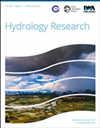城市化对墨西哥盆地南部含水层地下水潜在补给的影响
IF 2.4
4区 环境科学与生态学
Q2 Environmental Science
引用次数: 1
摘要
本文通过对GIS和卫星数据的收集、处理和分析,估算地下水补给的时间变化,并将其作为数值地下水流动模型的输入。收集了地质排列、土地利用、排水网络、岩性、地形和降水等资料。将这些信息进行空间化处理,然后利用基于入渗能力的层次分析法(AHP)计算各层重要度,确定潜在补给区。用水平衡方程用于计算PR体积。该分析从1970年到2019年每5年进行一次,考虑到平均城市面积的变化。在所有5年期间,城市面积的增加占研究总面积的16%至28%,而潜在补给则从平均降水量的23%下降至19%。1980 - 1994年和2010 - 2019年是城市扩张最显著的时期,与潜在补给减少的时期相匹配。然而,从2000年到2009年,与城市面积变化无关的PR略有增加,可能是由于温度变化。研究结果反映了研究区补给的时空动态,可作为地下水数值模型中实际补给的输入数据。本文章由计算机程序翻译,如有差异,请以英文原文为准。
Urbanization effects on the groundwater potential recharge of the aquifers in the Southern part of the Basin of Mexico
Collection, processing, and analysis of GIS and satellite data were performed in this work to estimate temporal groundwater recharge changes, which are needed as input in numerical groundwater-flow models. Layers of geological alignments, land use, drainage network, lithology, topography, and precipitation were collected. This information was spatialized, and then layer importance was calculated using an analytic hierarchy process (AHP) based on infiltration capacity to define potential recharge (PR) regions. A water budget equation was used to calculate PR volumes. The analysis was done every 5 years from 1970 to 2019, considering average urban area changes. For all study periods, an increase in urban area was calculated from 16 to 28% of the total study area, while potential recharge decreased from 23 to 19% of the mean precipitation values for each 5-year period. The most significant urban expansion was from 1980 to 1994 and 2010 to 2019, which match periods of potential recharge decrease. However, a slight increase in PR from 2000 to 2009, unrelated to urban area change, may be due to temperature variations. The results account for the spatial and temporal dynamics of the recharge in the study area and can be used as input data to calibrate the actual recharge in a groundwater numerical model.
求助全文
通过发布文献求助,成功后即可免费获取论文全文。
去求助
来源期刊

Hydrology Research
Environmental Science-Water Science and Technology
CiteScore
5.30
自引率
7.40%
发文量
70
审稿时长
17 weeks
期刊介绍:
Hydrology Research provides international coverage on all aspects of hydrology in its widest sense, and welcomes the submission of papers from across the subject. While emphasis is placed on studies of the hydrological cycle, the Journal also covers the physics and chemistry of water. Hydrology Research is intended to be a link between basic hydrological research and the practical application of scientific results within the broad field of water management.
 求助内容:
求助内容: 应助结果提醒方式:
应助结果提醒方式:


